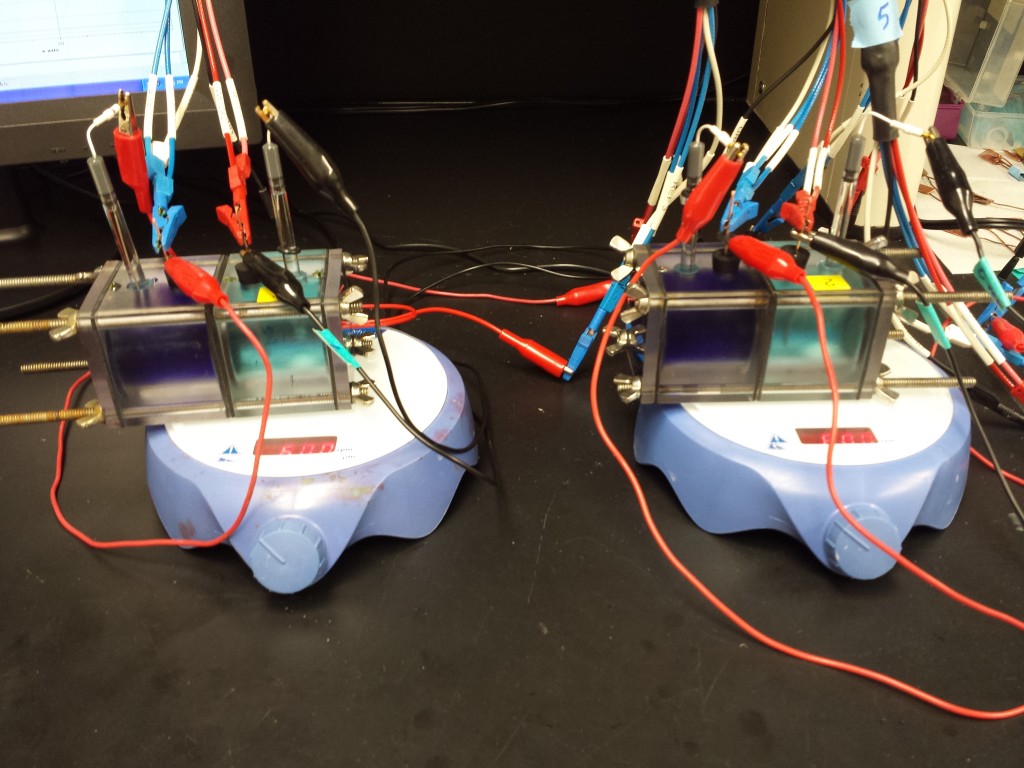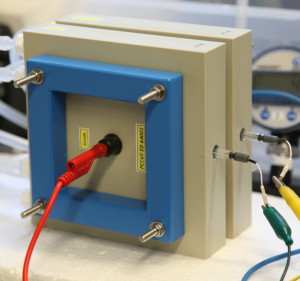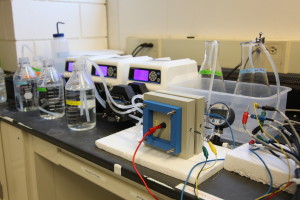PHOTOS
Cube TRAB Reactor
A closer view of the cube-type TRAB reactor (28 mL for each chamber) used in initial TRAB studies. The chamber with a light blue solution contains Cu(II), and the chamber with a dark blue solution contains both Cu(II) and ammonia. Electrochemical reactions occur on the surface of copper electrodes in both chambers.
TRAB Reactors
Two TRAB reactors showing the reference electrodes in each chamber that are used to measure the Cathode and anode potentials.
TRAB Reactors in Operation
TRAB reactors in operation, where the catholyte is stirred using a stir bar and stir plate, to reduce mass transfer limitations for ion transport to the cathode.
TRAB Configuration with Bottles
A different type of TRAB reactor configuration made using two bottles (each 80 mL) and a membrane clamped between the side arms.
Deposited and Corroded Copper Mesh Electrodes
Deposited (left) and corroded (right) copper mesh electrodes after one TRAB cycle.
Reverse electrodialysis (RED) stack (PCCell, Germany)
This is an electrodialysis stack, sold by PCCell in Germany, that can be used for RED tests. This photo emphasizes the endplate with an electrode (red wire) and the reference electrodes inserted into the two electrode chambers (green and yellow clips).
RED Stack Showing Inlets & Outlets
This is an electrodialysis stack, sold by PCCell in Germany, that can be used for RED tests. This photo emphasizes the inlet and outlet tubes for the stack, as well as for the electrode chambers (8 lines in all).
RED Stack with Solutions, Pumps, & Pressure Gage
This is the complete experimental setup, showing all the pumps, solution containers and pressure gages.
RED Stack with Solutions, Pumps, Potentiostat (Solartron)
Same as the above photo, but here we see the wires are connected to the potentiostat for setting current or potential and recording data.
MFRC
This is a microbial reverse electrodialysis fuel cell (MREC). When a high salt and low salt solutions are placed into alternating membrane pairs the reverse electrodialysis (RED) stack produces additional voltage. This allows the combined MRC to produce a higher voltage and power density than that possible by either the MFC or RED stack. The salt solutions can be natural (freshwater and seawater) or regenerable solutions using waste heat (such as ammonium bicarbonate). You can read about the MRC in our paper in Science by Cusick et al. (2011).
Data Logging Multimeter
A data logging multimeter is used to monitor voltage in the circuit containing a resistor. From the voltage and resistor information, we can calculate total power output by the system.










